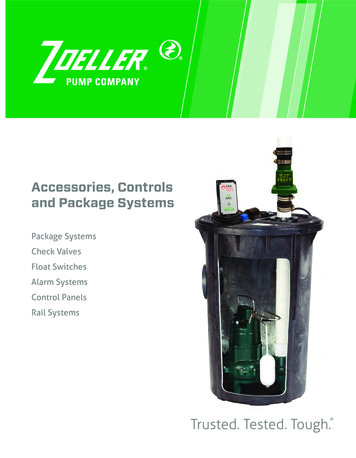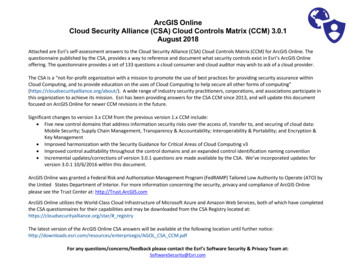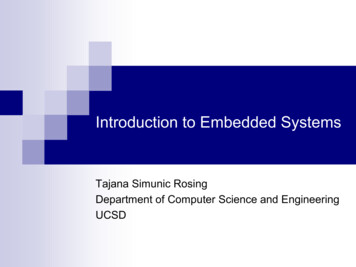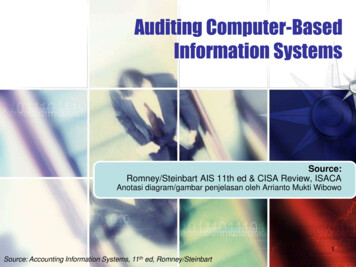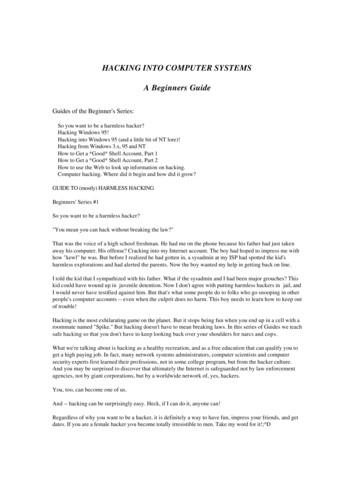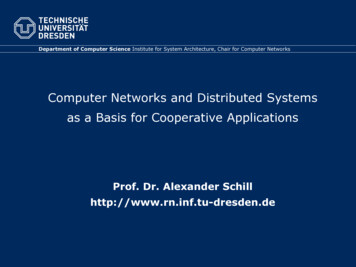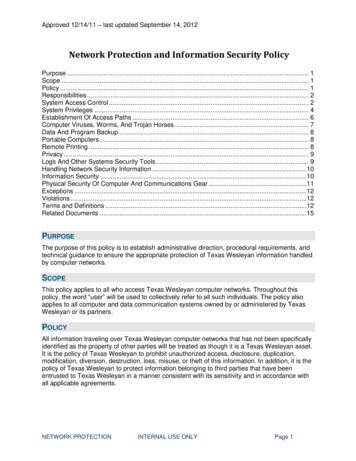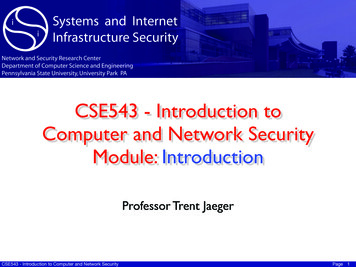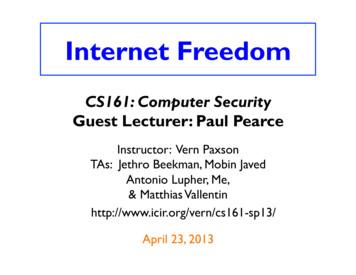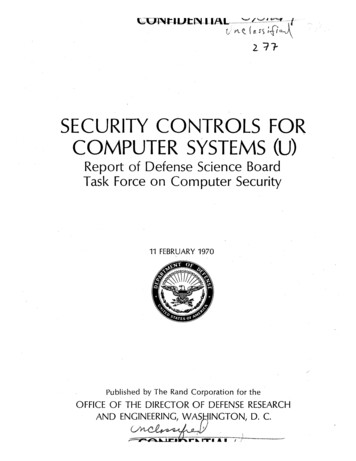
Transcription
\;.;- - 1-UI: --liA - - { - - ;·7) 1·''\!'2\\:r-rSECURITY CONTROLS FORCOMPUTER SYSTEMS (U)Report of Defense Science BoardTask Force on Computer Security11 FEBRUARY 1970·,Published by The Rand Corporation for theOFFICE OF THE DIRECTOR OF DEFENSE RESEARCHAND EN INEERING, WAS[JINGTON, D. C. -; ;/
Although this report contains no information not available in a well stockedtechnical library or not known to computer experts, and although there is littleor nothing in it directly attributable to classified sources, the partiCipation ofrepresentatives from government agencies in its preparation makes the informa tion assume an official character. It will tend to be viewed as an authoritativeDepartment of Defense product, and suggestive of the policies and guidelinesthat will eventually have to be established. As a prudent step to control dissemi nation, it is classified CONFIDENTIAL overall.
'-' :-.- .i ";,'SECURITY CONTRO'LS FORCOMPUT.ER SYSTEMS (U)Report of Defense Science BoardTask Force on Computer Security11 FEBRUARY 1970Published byThe Rand Corporation for theOFFICE OF THE DIRECTOR OF DEFENSE RESEARCHAND ENGINEERING, WASHINGTON, D. C.} (.:C) IriBEts.:l lts:l/'/
Published by The RAND Corporation
OFFICE OF THE DIRECTOR OF DEFENSE RESEARCH AND ENGINEERINGWASHINGTON, 0. C. 2030111 Febru·ary 1970MEMORANDUM FOR CHAIRMAN, DEFENSE SCIENCE BOARDSUBJECT:Final Report of Task Force on Computer System SecurityThe Task Force on Computer Security herewith transmits the final report on its study:Security Controls for Computer Systems. We visualize that this document will have wideinterest and application; therefore, it contains an informative discussion of the problemas well as guidelines for implementing solutions.It should be noted that this is the first attempt to codify the principles and details ofa very involved technical-administrative problem. Thus, this report reflects the bestideas of individuals knowledgeable about a problem which is relatively new, has beensolved only a few times, and has never been solved with the generality and breadth ofscope attempted in this report. There is no significant difference of opinion within theTask Force on the general content of this document. However, some aspects of theproblem are so new and controversial that there is a residual difference of opinion ona few fine details.Our recommendations and guidelines address the most difficult security control situa tion-a time-sharing multi-access computer system serving geographically distributedusers, and processing the most sensitive information. This report is a compilation ofthose aspects which should be considered separately and in combination when design ing or adapting computer systems to provide security control or user privacy. It isimpossible to address the multitude of details that will arise in the design or operationof a particular resource-sharing computer system in an individual installation.Thus, the security problem of specific computer systems must, at this point in time,be solved on a case-by-case basis, employing the best judgment of a team consistingof system programmers, technical hardware and communication specialists, andsecurity experts.This report provides guidance to those responsible for designing and certifying that agiven system has satisfactory security controls and procedures.vrfll\.ICIIlCl\.ITI A I
-- , . . , . , I II \LIn its study, the Task Force reached certain conclusions.1: · Providing satisfactory security controls in a computer system isin itself a system design problem. A combination of hardware,software, communication, physical, personnel, and administra tive-procedural safeguards is required for comprehensivesecurity. In particular, software safeguards alone are not suffi cient.2.Contemporary technology can provide a secure system accepta bly resistant to external attack, accidental disclosures, internalsubversion, and denial of use to legitimate users for a closedenvironment(cleared users working with classified information atphysically protected consoles connected to the system by pro tected communication circuits).3.Contemporary technology cannot provide a secure system in anopen environment, which includes uncleared users working atphysically unprotected consoles connected to the system by un protected communications.4.It is unwise to incorporate classified or sensitive information ina system functioning in an open environment unless a significantrisk of accidental disclosure can be accepted.5.Acceptable procedures and safeguards exist and can be imple mented so that a system can function alternately in a closedenvironment and in an open environment.6.Designers of secure systems are still on the steep part of thelearning curve and much insight and operational experience withsuch systems is needed.7.Substantial improvement (e.g., cost, performance) in security controlling systems can be expected if certain research areas canbe successfully pursued.This report contains a series of recommendations of use to designers, implementers,certifiers, and operators of secure systems. There is, however, a second and independ ent set of recommendations which are directed to the Defense Science Board. They arecontained only in this memorandum and are as follows.There is an immediate action item.The security policy directives presently in effect pro hibit the operation of resource-sharing computer sys tems. This policy must be modified to permit contrac tors and military centers to acquire and operate suchsystems. This first step is essential in order that ex perience and insight with such systems be . ac cumulated, and in order that technical solutions betried.Interim standards and regulations must be drafted to serve as design and operationalguidelines for the early resource-sharing security-controlling systems. Technical exper tise is required in the preparation of these documents and must be provided to theDirectorate of Security Policy at least initially, and perhaps also on a continuing basisto furnish both technical-assistance to operational systems and technical judgment forinterpretation of policy. There are several sources of concepts and specific recommen vi
dations for inclusion in interim regulations. They include this report, the documents ofthe DIA/ ANSR system, the JCCRG Collocation Study, and the documents of the NSAet ai/COINS system.There is also a near-term action item.A technical agent must be identified to establishprocedures and techniques for certifying security-con trolling systems, especially the computer software por tions and for actually certifying such systems.The need for this agent is immediate, but it will be difficult to create on short notice.System certification is a new technical area, and substantial technical expertise inseveral disciplines is required. Two models come to mind for such an agent. Theresponsibility could be assigned to an existing agency of government if it has therequisite skills, e.g., NSA, DIA, JTSA. Alternatively, an attractive idea is a multi-serviceagency, operated and staffed by a contractor, and created in the image of the Electro magnetic Compatibility Analysis Center.It is important to influence designers of future computers and software so that securitycontrols can be installed before the fact and as an integral part of the system. It is alsoimportant to ascertain what can be done with equipment presently installed or ownedby the government. Thus, a program of studies and research is required. This needshould be made known to various agencies of the Department of Defense that supportstudies and research in computers; some aspects of the program are appropriate forARPA. Typical topics are those whichFacilitate progress toward handling the open environment:A program of research to develop encryp tion devices to function internally within thecomputer proper.A program of research to investigate spe cial hardware configurations that can pro vide satisfactory security controls in anopen environment.Improve the understanding of. failure risks:A program of research to study the proc ess of certification, and to develop me . thodology for automatic recertification.Improve the efficiency of security controlling systems:A program of research to establish newcomputer architectures which can imple ment security control more efficiently andless expensively.· A program of research to study failuremodes in computer systems and to formu late methodology for accurately predictingfailure probabilities.Solve a latent and not fully understood leakage point:Continued research in methods for ade quately erasing information stored on mag netic media, i.e., sanitization or degaussing.Vllrry;,.l :11""\l:t.I'TI A I
Finally, it is suggested that the Task Force be maintained intact formally to providetechnical advice as required to the Directorate of Security Policy and the TechnicalAgent, and to designers, certifiers, and operators of secure systems.The issue of providing security controls in computer systems will transcend the Depart ment of Defense. Furthermore, the computing industry will eventually have to supplycomputers and systems with appropriate safeguards. Thus, the content of this reportis of interest to, and should be circulated to other government agencies, industry,research groups, and defense contractors.A number of working papers have been produced during this study. The Chairman willmaintain for five years a complete file of such documents, all relevant correspondenceand minutes, comments on draft reports, etc. At the end of th , t time, the material willbe microfilmed and deposited with an agency specified by the Defense Science Board.The Task Force and its members are available to assist in the implementing of any ofthese recommendations, and to assist with policy and technical issues which may arisein connection with formulation of policy and regulations for security controls in comput ers.Willis H. WareChairman, Task Forceon Computer System Securityviiirf\1'1. ll:lr'\1:11.111A I
CONTENTSMemorandum for the Secretary of Defense . iiiMemorandum for Chairman, Defense Science Board . . . . . . . . . . . . . . . . . . . . . . . . vPreface . xiIntroductionPart A.I.II.III.IV.v.VI.Part B.I.II.III.IV.v.VI.VII.VIII.Part C.I.II.III.IV.v.VI.VII.VIII.IX.X. . . . . XVNATURE OF THE PROBLEM .The Security Problem . . . . . . . . . . . . . . . . . . . . . . . . . . . . . . . . . . . . . . .Types of Computer Systems . . . . . . . . . . . . . . . . . . . . . . . . . . . . . . . . .Threats to System Security . . . . . . . . . . . . . . . . . . . . . . . . . . . . . . . . . .Areas of Security Protection . . . . . . . . . . . . . . . . . . . . . . . . . . . . . . . . .System Characteristics . , .Definitions .351012POLICY CONSIDERATIONS AND RECOMMENDATIONS .Fundamental Principles .System Personnel .Information Structure and Transforms .System Transaction Accounting . . . . . . . . . . . . . . . . . . . . . . . . . . . . . .Reliability and Auto-Testing .Information Security Labels .Management of Storage Resources .System Certification . . . . . . . . . . . . . . . . . . . . . . . . . . . . . . . . . . . . . . . .141414171819212122TECHNICAL RECOMMENDATIONS .Introduction .Central Processor Hardware .Software . . . . . . . . . . . . . . . . . . . . . . . . . . . . . . . . . . . . . . . . . . . . . . . . . . .Access Control Throughout the System .Communication Lines .Terminals . . . . . . . . . . . . . . . . . . . . . . . . . . . . . . . . . . . . . . . . . . . . . . . . . .Certification . : . . . . . . . . . . . . . . . . . . . . . . . . . . . . . . . . . . . . .Open Environment Considerations . . . . . . . . . . . . . . . . . . . . . . . . . . .Research Needed . . . . . . . . . . . . . . . . . . . . . . . . . . . . . . . . . . . . . . . . . . .Overall System Problems . . . . . . . . . . . . . . . . . . . . . . . . . . . . . . . . . . . .26262729313838ixrtll\.ll lnJ:I\.ITI A I11139424343
LVI'IriUCI'\j IIALPart D.MANAGEMENT AND ADMINISTRATIVE CONTROL . 46Appendix:AUTOMATION OF A MULTILEVEL SECURITY SYSTEM . 48Introduction . 48Computer System Catalogs . 50Security Control System Generation . 50Security Structure Definition . 51Personnel Security Definition and User ClearanceUpdate . 54Authorization Group Definition . 55Universal Privileges . 55Terminal Security Definition and Update . 56File Access Processing . 56Annex A: Formal System Access Specification . 58Annex B: Security Component Definition Examples . 62X
PREFACEThe question of security control in resource-sharing systems was broughtinto focus for the Department ofDefense by aseries of events in the spring andsummer of 1967. Such systems were being procured in increasing numbers forgovernment installations; the problems of security for them were becoming ofpressing concern both to defense contractors and to military operations; theResearch Security Administrators had forwarded a position paper through theDefense Supply Agen
08.10.1998 · Security Controls for Computer Systems. We visualize that this document will have wide interest and application; therefore, it contains an informative discussion of the problem as well as guidelines for implementing solutions. It should be noted that this is the first attempt to codify the principles and details of a very involved technical-administrative problem. Thus, this report reflects .
